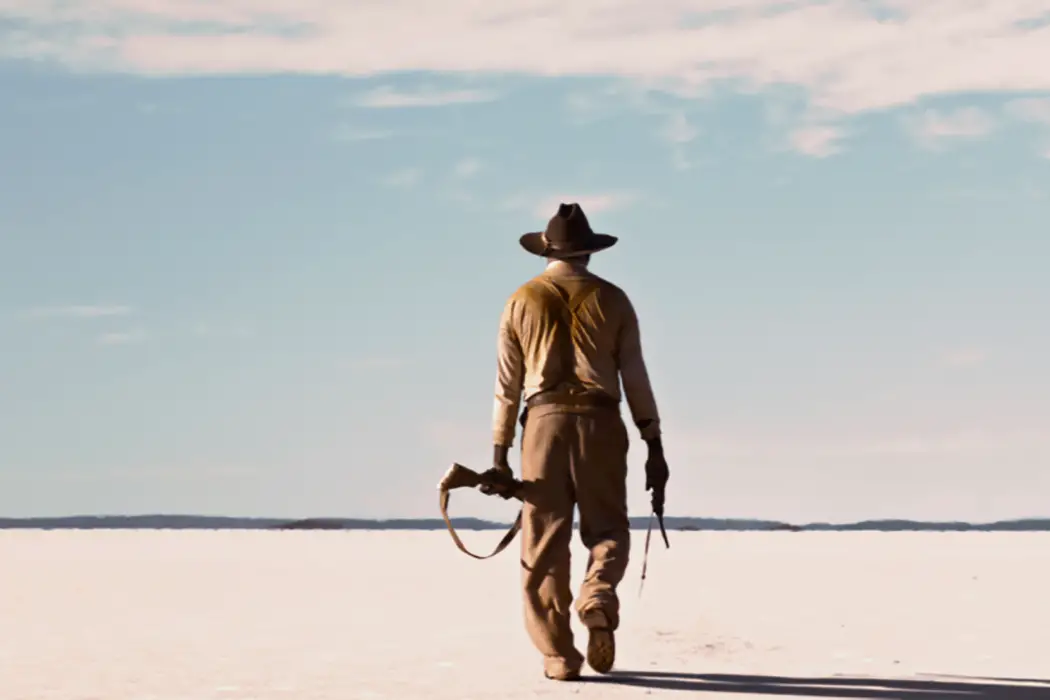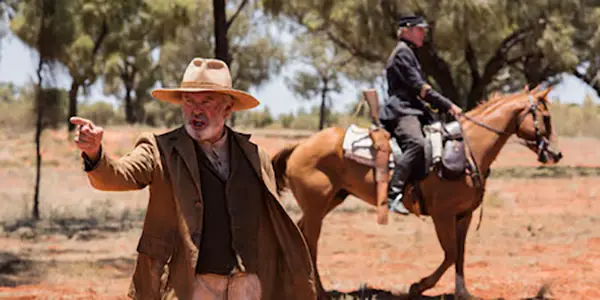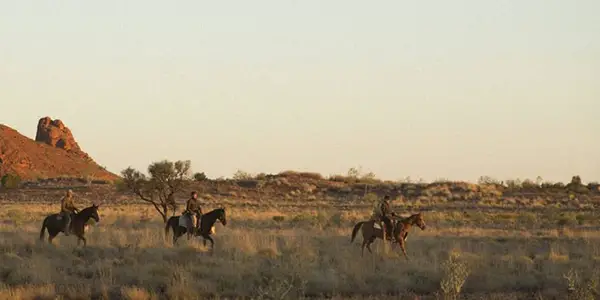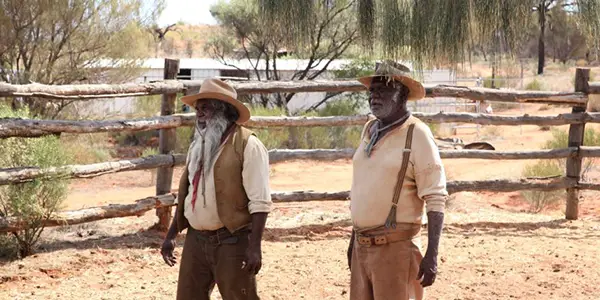SWEET COUNTRY: Magnificent Australian Western Touches On Universal Themes

David is a film aficionado from Colchester, Connecticut. He enjoys…
Westerns, even when made by a non-American (i.e. the Spaghetti Western), still typically focus on the American West during the mid 19th – early 20th centuries. Yet, it’s easy to forget that much of the underdeveloped world during this time was in a similar state of being – at the brink of civilization before the advent of modern vehicles and technology, living off the land in smaller communities, and with similar hierarchical ideals about race in relation to status in society.
Sweet Country focuses on a community and the circumstances involving an Aboriginal farmer who shoots and kills a white man in self-defense. The imagery in comparison to an American Western is clearly an influence, but through Warwick Thornton‘s distinguished vision, it’s soon clear that Sweet Country will be a modernized and fresh take on the genre.
The Vast Outback
Sweet Country takes place in Australia in the 1920s. It begins with Fred Smith (Sam Neill), a preacher who lives as a farmer in the Australian outback. He is approached by a neighbor named Harry March (Ewen Leslie), who asks for somebody to come with him to help string up his cattle. A busy man himself, Fred sends his assistant Sam Kelly (Hamilton Morris) along, who travels to March’s place along with his wife (Natassia Gorey-Furber) and the young Philomac (played by both Tremayne Doolan and Trevon Doolan).
Later on, March catches Philomac attempting to steal his watch, and he chains him up in his backyard. Philomac escapes, and March, in a drunken rage, hunts him down near Sam’s domicile, believing that Sam is hiding the boy. He barges into Sam’s house with guns blazing, demanding for him to give Philomac up. Knowing that March is beyond reason, Sam has no choice but to shoot him before either himself or his wife are in harm’s way. Despite the clear self defense, Sam knows that, given his Aboriginal background, people are unlikely to see it that way, so he and his wife go on the run through the Australian outback. A search party, led by Sergeant Fletcher (Bryan Brown), is soon sent after him, though Sam’s clear knowledge of the wilderness gives him the upper hand.

What’s immediately clear about Sweet Country is just how much of a standout it is in comparison to the typical American Western. Perhaps most distinctive is the sparse use of a background score. In a recent interview our site had with director Warwick Thornton, he gave his reasoning for this, explaining that: “It’s universal that the score/music in a movie is slightly abused, used in key points to make you laugh or cry, so you can get rid of it. The sound of the city, the sound of the forest or desert becomes much more apparent, it becomes much more grounded.”
In a way, it makes Sweet Country more akin to a film like Sergio Leone‘s Once Upon a Time in the West, which, while still utilizing an iconic score by Ennio Morricone, is often most effective when it lapses into long periods of silence, such as in its opening sequence. In these moments, as in much of Sweet Country, the feel of the surrounding landscape is much more amped up and direct as opposed to being manipulated by the background score.
Take the actual shooting scene, as an example. Harry March’s first approach and then pounding on Sam’s door is a series of thunderous booms, disruptive to the otherwise peaceful natural sounds of the outback. When Sam subsequently shoots March, the sound is deafening, followed by a shocked period of muffled silence that often results after a loud noise. By playing with these sounds, but in a way that feels natural, Thornton pulls you into his film through atmosphere alone.
Stark Visuals
As Sweet Country progresses, the cinematography of the outback is presented in full display, which was also done by Thornton himself. Some of the film’s more mesmerizing and haunting sequences come from here, utilizing both wide landscape shots and closeups. This can be seen during one scene when Sergeant Fletcher chases Sam across a desolate stretch of hazy desert, with the camera at one point showing him as the lone speck in a vast sea of emptiness. It’s so fiercely displayed that one can almost feel the heat in a similar manner as Fletcher, as the camera gazes up at the relentlessly scorching sun beating down on him.

There are also several distinctive editing techniques that Thornton uses during his film, which includes the splicing in of both flashbacks and flash-forwards. Presented without sound, these create a sense of intrigue, as we catch a glimpse into either a character’s thoughts or their future pending actions. As the film uses dialogue sparingly, it’s often during these sequences that we gain the largest sense of who these characters are.
Lack of Sugarcoating
The multilayered characters as a whole are one of the film’s strongest aspects. Thornton explains this in our interview: “In classic Westerns you’ve got good guys, who wear a white hat and the bad guys who wear a black hat, and their morals never cross paths and that’s bullshit, humanity doesn’t work like that.”
Take Sergeant Fletcher, who is played with perfect nuance by veteran Australian actor Bryan Brown. Though the character clearly becomes the story’s villain, he also shows a sensitive side, becoming romantically connected to a woman in town, and also holding his own set of moral beliefs. In contrast to the mob that wants to see Sam strung up without trial, Fletcher instead holds firm to the rule of law.

On the other side, Sam Neill‘s morally strong preacher easily holds the film’s good side in check, while fellow Aboriginal Archie (Gibson John) represents somewhere between the two extremes, mostly looking out for himself while also remaining sympathetic to Sam’s situation. Sam himself, who is warmly played by first-time actor Hamilton Morris, is also less than pure of heart, as he shows a darker side as well given a past wrongdoing done to him by Harry March.
The film’s use of multilayered characters also becomes more representative of its overall takeaway. Given its focus on race, it presents an unfortunate reality: an Aboriginal killing a white man, even in clear self-defense, is sure not to be seen in the same manner as it would if the situation were reversed. Thornton knows this, and his film reflects on this through the past, yet, though we don’t like to admit it, it is something that is just as prominent in our current world.
Though a clear revisionist Western, Sweet Country also doesn’t try to force-feed its message. As a contrast to a recent film like Scott Cooper‘s Hostiles, it is much more subtle in its final takeaway, refusing to amp up the sentimentality factor. It does present a glimmer of hope, but it’s one that feels more true to life as well.
Conclusion: Sweet Country
To conclude, Warwick Thornton‘s Sweet Country is further proof that sometimes you have to look outside America to truly gain an appreciation for the art of the Western. With poignancy, grit, and proficiency, it gazes out at the vast Australian outback while also deeply examining the darkness of humanity within. Do not miss it.
What did you think of Sweet Country? Are you a fan of Australian Westerns? Tell us your thoughts in the comments below!
Sweet Country was released in the UK on March 9, 2018 and will be released in the US on April 6, 2018. For all international release dates, see here.
Does content like this matter to you?
Become a Member and support film journalism. Unlock access to all of Film Inquiry`s great articles. Join a community of like-minded readers who are passionate about cinema - get access to our private members Network, give back to independent filmmakers, and more.
David is a film aficionado from Colchester, Connecticut. He enjoys writing, reading, analyzing, and of course, watching movies. His favorite genres are westerns, crime dramas, horror, and sci-fis. He also enjoys binge-watching TV shows on Netflix.













